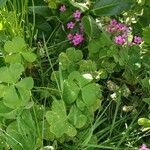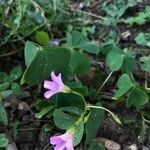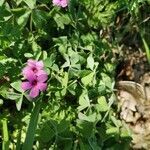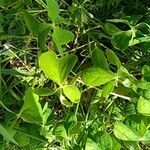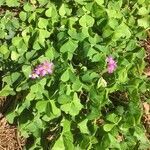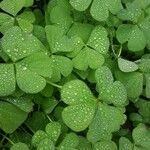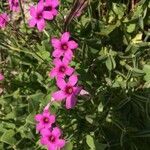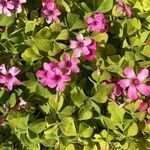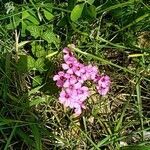Perennial acaulous herb with thick, fleshy, glassy white, contractile root below the main bulb which is surrounded by numerous small bulbils; tunic brown; scales 3-nerved. Lvs 3-foliolate. Petiole usually 7-20 cm long, glabrate or with scattered long hairs; stipular wing broad, membranous, hairy. Petiolule c. 1 mm long, hairy. Lamina of leaflets equal or nearly so, 10-35 × 12-48 mm, broadly obcordate, 2-lobed, rounded, with rather narrow sinus, glabrous or nearly so above, hairy beneath, finely punctate with raised orange calli beneath, especially round the margin. Infl. to 35 cm long, cymose, 3-7-or 10-18-flowered, with long curly hairs; pedicels ± deflexed, very variable in length. Bracts at base of pedicels, 2-3 mm long, with calli present but these often small. Sepals 4-5 mm long, ± elliptic, slightly hairy; calli 2-(4), prominent, orange, apical. Petals 1.5-2 cm long, oblong-obovate, pink to rose, glabrous. Stamens at 2 levels; filaments patently hirsute, dilated towards base, the longer 5-6 mm long. Styles either slightly < the shorter stamens or intermediate between stamen whorls, densely and patently hirsute. Capsule not seen.
Herbs perennial, acaulous, rhizomes and stolons absent, bulblets clustered; bulb scales 3-nerved. Leaves basal; petiole 10–25 cm; leaflets 3, green to yellowish green, rounded-obcordate, 17–40(–50) mm, lobed 1/6–1/5 length, <lobes apically convex>, adaxial surface hirsute, adaxial surface glabrous, oxalate deposits in dots at least around distal margins, often evenly over surface. Inflorescences irregular cymes, (3–)8–14(–28)-flowered; scapes 15–28 cm, moderately villous to glabrate. Flowers mostly homostylous, infrequently tristylous; sepal apices with 2 orange tubercles; petals violet to lavender or rose purple, 10–16(–20) mm. Capsules not observed. 2n = 14, 28, rarely 35.
A herb. It keeps growing from year to year. The flowers are red or purple.
